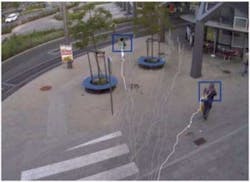Pedestrians tracked for scheduling, traffic control, and safety
In surveillance, a user-friendly and robust automated object detection and tracking system that can handle complex situations is not yet available. Recently, Oliver Sidla and his colleagues at SLR Engineering (Graz, Austria; www.slr-engineering.at) have taken a different approach from those underlying most current surveillance systems. Instead of generating a sophisticated background frame and using pixel differences between images, their system discovers pedestrians solely based on their appearance by learning what people look like.
The system’s algorithms can be taught the general shape and appearance of pedestrians based on thousands of manually created training samples, then tries to maintain a workable balance between generalization and sensitivity by slightly tuning the decision boundary as required during operation. As a result, the vision sensor’s performance becomes essentially independent of illumination and unaffected by panning and zooming. Inclement weather conditions do not significantly decrease performance.
Ultimately, the company aims to develop a smart camera-based system that detects, tracks, and counts pedestrians for applications in transportation hubs; e.g., to collect statistics of pedestrian flow, control and influence the timings of signalized pedestrian crossings, and provide real-world counting and traffic data for simulation models.

